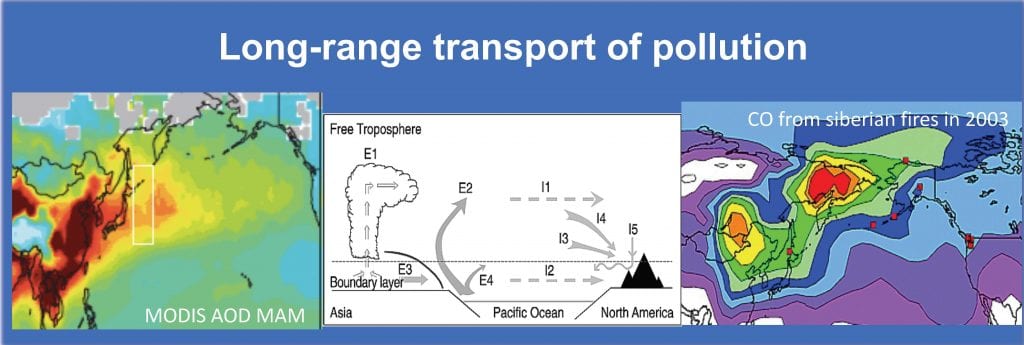
Regional air pollution has been a significant concern in many parts of the world since the industrial revolution. While industrialized nations have been actively working to improve their air quality by reducing local emissions, many developing countries are now facing growing air pollution problems because of their rapid population and economic growth. Atmospheric transport between continents takes 1-2 weeks on average and, as a result, continental emissions of even short-lived species (lifetimes of weeks to months) can affect the atmosphere above other continents. Thus, in addition to acute local impacts on the source continents, the intercontinental transport of air pollution to receptor regions downwind has far-ranging effects air quality, climate, and visibility.
We have been particularly interested in combining the GEOS-Chem chemical transport model together with satellite, aircraft and ground-based observations to help constrain long-range transport of :
- pollution from Asia to the U.S. (Kotchenruther et al., 2001; Jaeglé et al., 2003; Liang et al., 2004, 2005, 2007; Weiss-Penzias et al., 2004; Goldstein et al., 2004; Strode et al., 2008; Fischer et al., 2010; Luan et al., 2012; Zhang et al., 2013)
- pollution and dust from Asia to the Arctic (Di Pierro et al., 2011);
- pollution from Europe and North America to the Arctic (Mackie et al., 2016);
- transport and sinks of aerosols over the Arctic (Di Pierro et al., 2013);
- biomass burning from Siberia (Bertschi et al., 2004; Jaffe et al., 2004) and Africa (Sinha et al., 2004; Sauvage et al., 2007);
- dust from the Sahara (McKendry et al., 2007).
Publications:
- Mackie, A.R., et al., 2016. Reduced Arctic air pollution due to decreasing European and North American emissions. J. Geophys. Res.-Atmos. 121, 8692–8700. https://doi.org/10.1002/2016JD024923
- Di Pierro, M., Jaeglé, L., Eloranta, E.W., Sharma, S., 2013. Spatial and seasonal distribution of Arctic aerosols observed by the CALIOP satellite instrument (2006-2012). Atmos. Chem. Phys. 13, 7075–7095. https://doi.org/10.5194/acp-13-7075-2013
- Luan, Y., Jaeglé, L., 2013. Composite study of aerosol export events from East Asia and North America. Atmos. Chem. Phys. 13, 1221–1242. https://doi.org/10.5194/acp-13-1221-2013
- Zhang, Y., Jaeglé, L., 2013. Decreases in Mercury Wet Deposition over the United States during 2004-2010: Roles of Domestic and Global Background Emission Reductions. Atmosphere 4, 113–131. https://doi.org/10.3390/atmos4020113
- Di Pierro, M., Jaeglé, L., Anderson, T.L., 2011. Satellite observations of aerosol transport from East Asia to the Arctic: three case studies. Atmos. Chem. Phys. 11, 2225–2243. https://doi.org/10.5194/acp-11-2225-2011
- Fischer, E.V., Jaffe, D.A., Reidmiller, D.R., Jaeglé, L., 2010. Meteorological controls on observed peroxyacetyl nitrate at Mount Bachelor during the spring of 2008. J. Geophys. Res.-Atmos. 115, D03302. https://doi.org/10.1029/2009JD012776
- Strode, S.A., Jaeglé, L., Jaffe, D.A., Swartzendruber, P.C., Selin, N.E., Holmes, C., Yantosca, R.M., 2008. Trans-Pacific transport of mercury. J. Geophys. Res.-Atmos. 113, D15305. https://doi.org/10.1029/2007JD009428
- Liang, Q., Jaeglé, L., et al., 2007. Summertime influence of Asian pollution in the free troposphere over North America. J. Geophys. Res.-Atmos. 112, D12S11. https://doi.org/10.1029/2006JD007919
- McKendry, I.G., et al., 2007. Trans-Pacific transport of Saharan dust to western North America: A case study. J. Geophys. Res.-Atmos. 112, D01103. https://doi.org/10.1029/2006JD007129
- Sauvage, B., et al., 2007. Remote sensed and in situ constraints on processes affecting tropical tropospheric ozone. Atmos. Chem. Phys. 7, 815–838. https://doi.org/10.5194/acp-7-815-2007
- Liang, Q., Jaeglé, L., Wallace, J.M., 2005. Meteorological indices for Asian outflow and transpacific transport on daily to interannual timescales. J. Geophys. Res.-Atmos. 110, D18308. https://doi.org/10.1029/2005JD005788
- Bertschi, I.T., Jaffe, D.A., Jaeglé, L., Price, H.U., Dennison, J.B., 2004. PHOBEA/ITCT 2002 airborne observations of transpacific transport of ozone, CO, volatile organic compounds, and aerosols to the northeast Pacific: Impacts of Asian anthropogenic and Siberian boreal fire emissions. J. Geophys. Res.-Atmos. 109, D23S12. https://doi.org/10.1029/2003JD004328
- Goldstein, A.H., et al., 2004. Impact of Asian emissions on observations at Trinidad Head, California, during ITCT 2K2. J. Geophys. Res.-Atmos. 109, D23S17. https://doi.org/10.1029/2003/JD004406
- Jaffe, D., Bertschi, I., Jaeglé, L., Novelli, P., Reid, J.S., Tanimoto, H., Vingarzan, R., Westphal, D.L., 2004. Long-range transport of Siberian biomass burning emissions and impact on surface ozone in western North America. Geophys. Res. Lett. 31, L16106. https://doi.org/10.1029/2004GL020093
- Liang, Q., Jaeglé, L., Jaffe, D.A., Weiss-Penzias, P., Heckman, A., Snow, J.A., 2004. Long-range transport of Asian pollution to the northeast Pacific: Seasonal variations and transport pathways of carbon monoxide. J. Geophys. Res.-Atmos. 109, D23S07. https://doi.org/10.1029/2003JD004402
- Sinha, P., Jaeglé, L., Hobbs, P.V., Liang, Q., 2004. Transport of biomass burning emissions from southern Africa. J. Geophys. Res.-Atmos. 109, D20204. https://doi.org/10.1029/2004JD005044
- Weiss-Penzias, P., Jaffe, D.A., Jaeglé, L., Liang, Q., 2004. Influence of long-range-transported pollution on the annual and diurnal cycles of carbon monoxide and ozone at Cheeka Peak Observatory. J. Geophys. Res.-Atmos. 109, D23S14. https://doi.org/10.1029/2004JD004505
- Jaeglé, L., Jaffe, D.A., Price, H.U., Weiss-Penzias, P., Palmer, P.I., Evans, M.J., Jacob, D.J., Bey, I., 2003. Sources and budgets for CO and O3 in the northeastern Pacific during the spring of 2001: Results from the PHOBEA-II Experiment. J. Geophys. Res.-Atmos. 108, 8802. https://doi.org/10.1029/2002JD003121